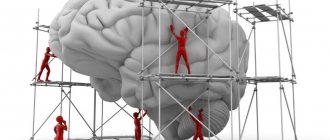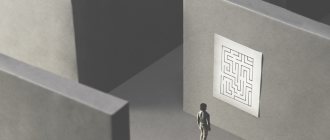11/25/20205 minutes read 559
Art therapy
(from the English art - “art” + therapy) - a direction in psychotherapy and psychology, based on the use of art and creativity in the treatment of psychological problems and diseases. The main goal of art therapy is the harmonization of the mental state, self-expression and self-knowledge, and the actualization of suppressed emotions. In the process of therapy at the symbolic level, a person can express and explore all his feelings, conscious and hidden: love, hatred, anger, envy, tenderness, joy, sadness, pain, etc.
Initially, this technique was used in the psychoanalytic school; its main mechanism is sublimation.
Sublimation is a protective mechanism of the psyche, which is the removal of internal tension by redirecting energy to achieve socially acceptable goals and creativity.
First described by Freud
Types of art therapy in modern psychology
Art therapy can be used both as the main method of treatment and as one of the auxiliary methods during complex therapy. Its main healing property is that a person, through creative activity, can express feelings that are difficult to formulate in words. Having created an image and seen it, he can interpret his emotions and resolve the conflict, transform negative emotions into positive ones, and find a way out of a disturbing situation.
There are many ways to express yourself, and you don't even need to know how to paint, sculpt or dance. Absolutely everyone can find for themselves the type of art therapy, from many directions, that will best solve the problem.
- Dance therapy
- Art therapy (drawing, collage)
- Fairytale therapy (bibliotherapy)
- Music therapy
- Puppet therapy
- Working with plastic materials - modeling techniques, sculpture, pottery
- Sand therapy
- Mandalotherapy
- Phototherapy
- Animation therapy, etc.
Art therapy exercise “Image of a goal” - Define your goal. Traditional: “I want a lot of money” is not a goal, but a means to achieve it. - Draw your goal. Work out all the details, take your time. - Now that it has become embodied, think about what you need to achieve your goal?
What is art therapy and what does it give?
The name “art therapy” speaks for itself, and, in simple terms, means treatment with art. But it is much more important to understand exactly how this treatment occurs, because there are no medications, injections or even massage. All this is replaced by paper and pencils or paints, clay or sand, plasticine or photographs. Moreover, this is not all that, as it turns out, has a healing effect.
Art therapy can be called a kind of connecting link between a person’s consciousness and subconscious, the so-called bridge between the mind and soul. And the idea here is that most of a person’s problems stem precisely from the deep subconscious level, and not from the surface conscious. That is why drug treatment is often powerless for them.
As a psychotherapeutic direction, art therapy was formed a long time ago - approximately in the middle of the twentieth century, appearing at the intersection of psychological science and art. But in this relatively short time, it has gained such popularity that millions of people around the world have become its adherents.
The main value of therapy through art is that with its help you can balance and harmonize your mental state, increase your abilities for self-expression, reflection and self-knowledge, unleash your creative potential and tap into internal reserves.
Thanks to art, you can experience most known feelings and emotions on a symbolic level: love, joy, delight, passion, hatred, resentment, anger, anger, fear, disappointment, etc. And the experience of any of these feelings occurs in a positive form, i.e. a person is 100% free from receiving any mental or emotional trauma.
When a person sculpts figures, writes poetry, reads some stories, paints, creates collages from photographs, he is not just engaged in solving one specific narrow problem, but learns to see situations from the perspective of an observer, look deeper, understand himself and his life, and find answers. to many fundamental questions.
Art therapy allows a person to understand his purpose, the meaning of life, global purpose, his own value and what he can give to this world. It turns out that this is no longer treatment, but deep work with your consciousness.
Art therapy methods/techniques
- Art therapy is healing through creativity; this technique allows you to establish a connection between the subconscious and the conscious part of the psyche. The basis of the method is a metaphor that reveals the causes of psychological problems and difficulties. In the process of creativity, these reasons unconsciously come to the surface, and the person uses available materials to create their images, and then, under the guidance of a psychologist or independently, works with these images.
- Work can be done actively or passively. Active - an active creative process occurs: a person independently draws, sculpts or composes a fairy tale or story. Passively - the client listens to music or looks at a work of art, watches a film, and interprets the information, isolates what causes the greatest response, what constitutes the image of his problem.
- Art therapy methods can also be carried out in a group or individually. In a group, people can engage in joint creativity, work on a project together or individually within the framework of a topic given by the art therapist.
How art therapy allows you to bypass the censorship of consciousness
Art therapy (literally “healing through creativity”) is a direction of psychological correction that helps a person diagnose and resolve internal conflicts, realize and express suppressed feelings, and gain integrity. Art therapeutic practices accompany us throughout our lives: from the first conscious games to the last story told.
Modern people are accustomed to thinking logically and consistently: we are taught concrete thinking from the first years of life. However, a significant part of the acquired impressions and knowledge remains unconscious - the beliefs and traumatic experiences absorbed in childhood associated with forbidden, socially unacceptable or dangerous experiences are ignored or repressed by our consciousness. We forget why we decided that obeying our elders is good, but doing things our own way is bad. We do not notice our own aggressive behavior and fall into a state of learned helplessness where we are objectively capable of influencing events. And most importantly, in pursuit of logic and consistency, we cease to feel our own desires and aspirations.
However, desires, fears, suppressed emotions and a sense of one’s own capabilities do not disappear anywhere. They live in the subconscious and, under the influence of external stimuli, from time to time come to the surface in the form of emotionally charged images. People who are far from creativity contact them through dreams, reading books, watching films. When you wake up in fear or in tears, cry bitterly over a movie, criticize an advertisement, see a whole story behind a picture on a candy wrapper, or desperately envy the hero of a book - you react emotionally not only to an external stimulus, but above all to your own internal process.
Emotional reactions are subconscious clues, road signs. They say: “Come here! This is important now."
Art therapy easily allows you to bypass the censorship of consciousness and bring suppressed states and desires into the realm of awareness - those that are relevant right now.
This is not easy to do. The images of the unconscious must pass through the resistance that blocks incomprehensible, “unreasonable” and “harmful” desires and states. Resistance is our friend. If not for it, chaotic emotional reactions to external stimuli would deprive us of the ability to make informed decisions. The balance between normal protective resistance and awareness of the actual process is art therapy.
The purpose and objectives of art therapy
Therapy solves many problems in a very humane and safe way for humans:
- A socially acceptable outlet for aggression and other negative feelings. It is possible to express negative feelings without harming yourself or others. Modeling is especially well suited for these purposes.
- Facilitates the process of treatment (psychotherapy) as an auxiliary method. Therapy can be used as an auxiliary technique in the treatment of both psychological and somatic problems, for example, in case of heart disease, when it is necessary to overcome the patient’s anxiety after a heart attack.
- Provides rich material for psychodiagnostics. Absolutely everything that a person uses for creativity is interpreted by a psychologist, and subsequently by the patient themselves: the type of therapy, material, color, location of the drawing on the sheet, the size of the sculpture, even the inability to depict something, every detail related to the creative process - All this is material for diagnostics.
- Processing repressed thoughts and feelings. During the creative process, all repressed, hidden feelings begin to be recognized by the client.
- Therapist-client contact. This is especially helpful when working with children.
- Development of self-control.
- Concentration on sensations and feelings.
- Development of creative abilities. Both passive and active forms of art therapy develop creative thinking and increase sensitivity to art.
- Increased self-esteem.
Exercise “Doodle” 1. Draw a complex tangle of lines, meaninglessly and freely drawing on the surface of the sheet, using any tools (paints, pencils, pens, crayons). 2. Try to “see” a certain image in these scribbles and develop this image meaningfully - using the same colors (pencil) 3. Write a short story or give a detailed commentary on the resulting image.
Pros and cons of using art therapy
The advantages of art therapy include the fact that it is an inexpensive and accessible method. You can work on your own and make quite a lot of progress. This is a very good way to get to know yourself, cope with stress and negativity, identify goals, actualize problems and hidden emotions.
But like any working method, art therapy has its disadvantages:
- during creative self-expression, an uncontrolled explosive release of strong emotions is possible; if there is no experienced psychologist nearby, a person may not be able to cope with their influx;
- in some (rather rare) cases, negative character traits may worsen - narcissism, psychotic traits;
- rather than helping to connect with others, art therapy can promote deeper withdrawal;
- For some, this method is categorically not suitable and causes strong protest - usually this is a violent manifestation of the defense mechanisms of the psyche
Is it worth practicing art therapy?
The characteristic feature and main difference between art therapy and any other psychotherapeutic technique is its absolute harmlessness and gentle effect on the practitioner. It is impossible to cause any harm with the help of creativity, especially if a professional is involved in the matter.
In addition, art therapy addresses a person’s subconscious, helps him get to the characteristics and resources hidden deep within, promotes the development of creativity and imaginative thinking, allows him to escape from everyday worries and enjoy the creative process.
Along with receiving emotional satisfaction and aesthetic pleasure, a person learns to better adapt to the conditions of the surrounding world, becomes stronger and more protected psychologically, gains greater self-confidence, and develops stress resistance.
Creative activities, especially if they are systematic, give a person the opportunity to experience new positive experiences and accumulate them. Art therapy helps to solve many problems and problems, including age-related and personal problems, conflicts, losses, and various kinds of crises.
All this suggests that it makes sense to try to engage in treatment with the help of creativity. Many people even call art therapy a real path to their soul - a path that is exciting, interesting, unusual and full of vivid images and rich positive experiences.
The process itself and the results that can be achieved with the help of art therapy are interesting and worthy of attention. By practicing it regularly, you can completely change your view of the world, life and yourself, and acquire the vision of a creator - a poet, artist or writer who independently writes the script of his life.
Along with this comes an understanding of your deepest essence, true desires and purpose. We hope that our thoughts will encourage you to add a trickle of creative energy to the river of your life, and help you find a way to make your world even more colorful, lively and interesting.
Did you like the article? Join our communities on social networks or our Telegram channel and don’t miss the release of new useful materials: TelegramVKontakteFacebook
We also recommend reading:
- Storytelling
- MAC therapy: the first step on the path to yourself
- Art therapy methods
- Acceptance and Commitment Therapy (ACT)
- 9 most unusual methods of therapy: about the past, present and future
- Hakomi Therapy
- Narrative therapy
- Positive therapy for children
- Play therapy when working with children
- Psychological intervention
- Creative Expression Therapy
Key words:1Psychoregulation
Areas of art therapy
- Dynamically oriented
art therapy has its origins in psychoanalysis and is based on the interpretation of hidden thoughts and feelings extracted from the subconscious and materialized through the means of art. Every person, even a small child, is able to express an internal conflict in a visual (auditory) form, and then it is easier to explain and understand, and therefore solve.
- Gestalt-oriented art therapy.
The psychotherapist helps the client to understand and interpret experiences, restore the integrity of the “I,” and awaken spontaneity and vitality.
Art therapy for children
Therapy is recommended for children from 6 years old (some therapists can work with children from 4 years old) since at the age of 6 years the symbolic function of consciousness is still being formed, the child does not yet know how to abstract. The parent can be present at the session and be included in the process or occupy the position of an observer.
But for teenagers, this form of psychotherapy can be very useful; teenagers strive for self-expression, have already largely mastered the methods (drawing, modeling, writing), but cannot fully navigate their emotions, desires, and goals. Art therapy approaches are ideal for this age group. The parent is usually not present at the session.
Art therapy for adults
Every person can express themselves creatively, but the older we get, the more this magical ability is lost. Adults are crushed by routine and far-fetched prohibitions; they forbid themselves to dance, draw, and are afraid of getting dirty with clay or plasticine. Feelings are suppressed, thoughts are blocked, so physical, psychological and neurotic disorders arise.
By throwing out emotions on canvas or on the dance floor, people get rid of blocks, healing themselves with simple remedies from both psychological and somatic diseases. And what is important for adults in art therapy sessions is that no one is compared to anyone else, work is not evaluated - this is not a painting lesson.
Exercise “Avatar - the image of the soul” - Imagine any object that is most similar to you (plant, animal, inanimate object, whatever you can imagine). - Draw it however you like - draw it perfectly or sketch it out schematically. — It is important that this work reflects your current state. - Consider your image, reflect on it. Why did you choose this particular image? Where did these details, colors, decorations come from? What do you like most about the look? What's not to like? What would you like to change?
Art therapy for older people
In Europe and the West, art therapy of emotions is widely used among older and older people. Groups and centers are created for them, using therapy approaches that are accessible to everyone.
Maturity is a wonderful time when a person can completely surrender to his hobbies, stop running somewhere and start simply living. But this is also the time when you can fall into the state of “life without a goal.” The usual way of life of older people is crumbling, children grow up, parents begin to feel unnecessary, retirement begins and a lot of free time appears, and in order to find new meanings, energy and effort are required.
Art therapy methods provide an opportunity to discover your creative potential and find energy for living a life of pleasure.
Who needs art therapy and what problems does it solve?
Surely you are interested in the question of who most often turns to art therapy. In fact, hundreds of people come to specialists in this area - art therapists - with a variety of problems and requests. But, of course, among them we will not find negative people, skeptics and those who absolutely do not need any changes in life and themselves.
Otherwise, art therapy is suitable for adults, children, men and women, and in all cases, without exception, it gives excellent results. More specifically, it helps adults reconsider some important but problematic things, develop new behavioral models, and develop creativity.
When it comes to children, methods that are more suitable for them are used, such as isotherapy, fairy tale therapy, sand therapy and others (we will talk about them a little later). By the way, they are partially used in their work by child psychologists, educators, special education teachers, speech therapists, and instructors in development centers.
Using various techniques, art therapists develop children's thinking, reveal their creative potential, try to influence the proper formation of the nervous system and psyche, teach them to interact with other children, and maintain an optimal level of intellectual activity.
Art therapy is ideal for children with developmental disabilities, disabled children, children suffering from vision and motor problems, autism and cerebral palsy. Not only the exercises they perform have a beneficial effect on their condition, but also the very atmosphere in which children work out – playful and interesting, cheerful and friendly, corrective and developing.
If we summarize the above, we can highlight several main areas in which art therapy works:
- disclosure and development of creativity;
- assistance in establishing contact with yourself and your inner world;
- establishing or restoring contact with other people;
- building relationships;
- relaxation and relaxation;
- help in realizing your true feelings, desires and goals;
- correction of behavior and replacement of ineffective behavioral models with effective ones;
- assistance in achieving balance between the inner world and the conditions of the surrounding reality;
- reduction and complete elimination of the negative effects of stress;
- general development;
- formation of positive thinking.
There is also a whole range of specific tasks that this direction can cope with quite successfully:
- Diagnostics . Through creativity, it is possible to identify a person’s deep-seated problems and point him to those areas of internal and external life and personal qualities that need to be paid serious attention to, that need to be worked out or changed.
- Correction . Thanks to effective art therapy, specialists help people change their behavior for the better, get rid of anxieties and fears, feelings of guilt and self-pity, limiting beliefs, complexes, pressures, etc.
- Development . Art therapy helps not only to identify a person’s strengths and weaknesses, but also to develop them. This means that while doing a pleasant thing, a person also does serious work on himself.
- Pleasure . Healing occurs through the process of creation. People paint pictures, compose poems, take photographs, in a word – create, but isn’t this where true pleasure lies?! Moreover, even people who are far from creativity receive it.
- Psychotherapy . Creative activity helps to overcome difficult experiences, eliminate psychological trauma, remove subconscious blocks, get rid of self-doubt and solve other similar problems.
Art therapists use a huge number of different methods in their work. In addition, people themselves have different preferences, but anyone can find something that suits their taste.
How does a consultation with an art therapist work?
This can be either an individual consultation or group work. The session lasts from an hour to an hour and a half, and begins with elaboration of the request. The therapist will ask you what brought you here and what problems you want to solve. The psychologist will ask leading questions and use various approaches to help formulate the request and clearly define the problem.
A highly qualified therapist will never give advice or explain the problem for you; he can only help you explore the depths of your soul and move towards resolving the conflict. Also, an art psychotherapist will not explain to you “what is it that you drew,” only you can interpret your creativity.
How long does art therapy last?
It depends on the depth of the problem, and how long it has been bothering you, on the specific situation and the person himself. You need to understand that psychotherapy in general is a long process that can last from one meeting to six months and even several years.
Typically, these are weekly meetings, but at least once a month, and regularity is very important to achieve effective results. There are also short-term options - about 20 sessions. Everything is individual, but miracles do not happen, and it is impossible to solve problems that have been accumulating for 20-30 years in one meeting.
What results can you expect from a consultation with a psychoanalyst?
Therapy has a beneficial effect on a person’s psychological and emotional background. Using this technique, you can resolve internal conflicts and achieve harmony and your own psychological peace.
Here are the main results that clients of art therapists achieve:
- awareness of emotions and feelings and their deep elaboration;
- resolving internal psychological conflicts in a way that is safe for the person and others;
- knowledge of hidden driving motives;
- relief of emotional pain;
- discovery of new personal resources;
- updating goals and ways to achieve them.











